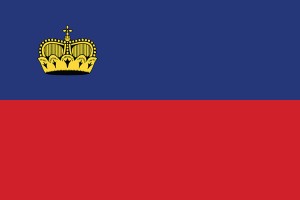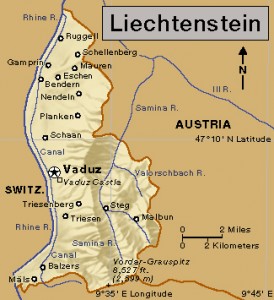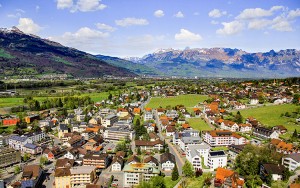Liechtenstein 300
January 23, 2019
Today, January 23, marks the 300th anniversary of the establishment of the small south-central European nation of Liechtenstein. On Jan. 23, 1719, Liechtenstein became an autonomous principality within the German-based Holy Roman Empire. The small monarchy gained complete independence in 1806 with the creation of the Confederation of the Rhine during the Napoleonic Wars. Liechtenstein is one of the world’s smallest countries. It covers only 62 square miles (160 square kilometers) and has only about 39,000 people.

Liechtenstein’s flag has two horizontal stripes, the upper one blue (for the sky), and the lower one red (for the glow of evening fires). A crown representing the prince appears in the upper-left corner. Credit: © Loveshop/Shutterstock
Today, Liechtenstein’s “Birthday Party” begins with a meeting at the Scheidgraben, a symbolic ditch that marks the border between the nation’s Oberland (south) and Unterland (north). Liechtenstein was created from the pairing of the Dominion of Schellenberg (the Unterland) and the County of Vaduz (the Oberland). A bell-ringing then starts synchronized festivities in Vaduz, Liechtenstein’s capital; the nearby town of Schaan; and other towns throughout the country. Hans-Adam II, the Prince of Liechtenstein and head of state, will make an appearance in Vaduz, as will his son Prince Alois, who has been Liechtenstein’s head of government since 2004.

Click to view larger image
Liechtenstein is one of the world’s smallest countries. Credit: WORLD BOOK map
Liechtenstein lies along the Rhine River between Switzerland and Austria, and has many close ties with the Swiss. Most of the people speak Alemannic, a German dialect. Liechtenstein uses Swiss money, and Switzerland operates its postal and telephone systems. Switzerland also represents Liechtenstein in the country’s diplomatic and trade relations. Like Switzerland, Liechtenstein does not belong to the European Union. Also like Switzerland, Liechtenstein has maintained its neutrality through several wars. Liechtenstein has not fought in a war since 1866. Its name in German, the official language, is Fürstentum Liechtenstein (Principality of Liechtenstein).
Liechtenstein is a constitutional monarchy. It is ruled by a prince who is the head of the House of Liechtenstein. The throne usually passes to the prince’s eldest son.
Because of its central location in Europe, the area that is now Liechtenstein has been continuously inhabited since 3000 B.C. Charlemagne, king of the Franks, controlled the area in the late A.D. 700′s. After his death in 814, the region was divided into two independent states, Vaduz and Schellenberg. Both states later became part of the Holy Roman Empire. Johann-Adam Liechtenstein, a prince from Vienna, acquired Schellenberg in 1699 and Vaduz in 1712. His descendants still rule Liechtenstein.



